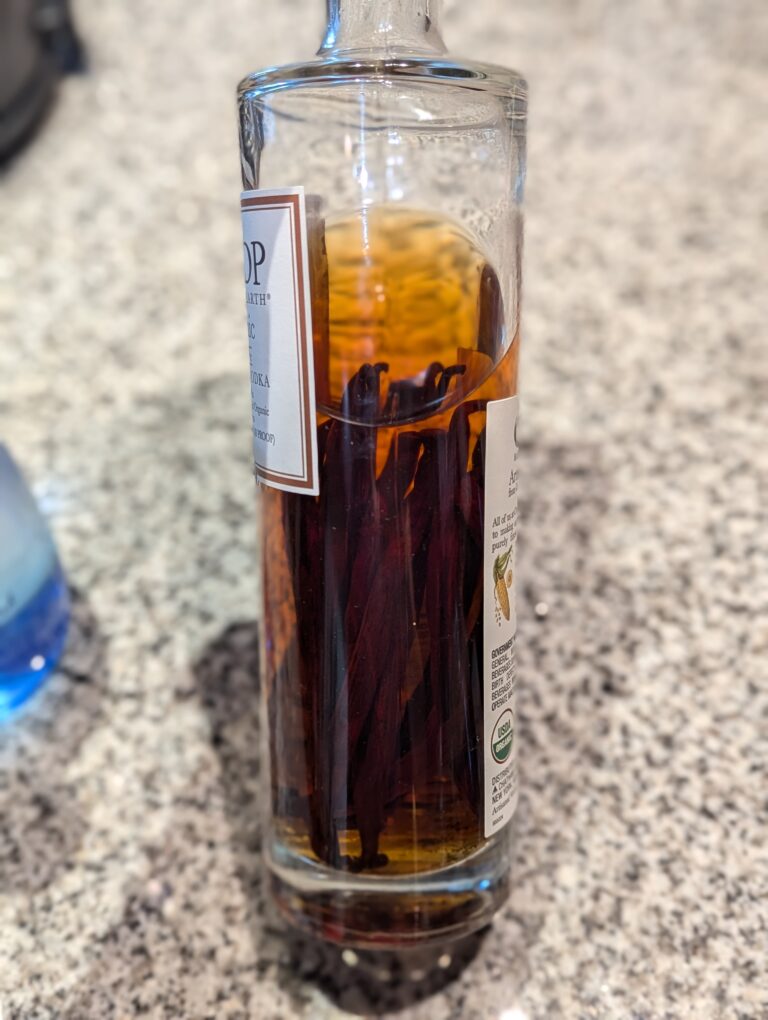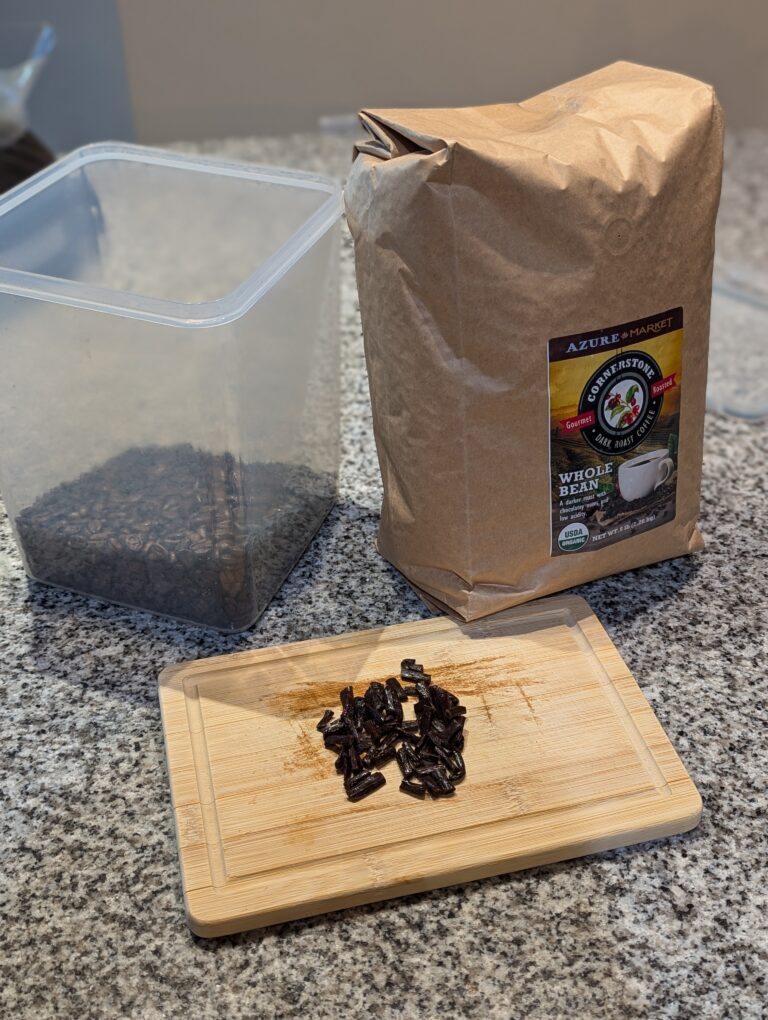My Silver Lining
I have a problem.
I have a really hard time facing a problem and not fixing it. In a culture of “venting” just to get something off your chest with no intention of changing anything, I have to actually (and very uncomfortably) sit on my hands, so to speak.
But not today! The whole reason this blog exists is to satiate my “fix it” nature. So here’s how I fixed my vanilla extract situation.

So What's the Matter with Vanilla?
The sky isn’t falling or anything but the cost of vanilla is the most obvious issue. Especially if you spend any time cooking regularly. Until mine was ready, I used , Flavorganics organic vanilla. And it is a great option; however, it is only 2 fluid ounces for approximately $8. I was buying it ever other grocery store run!
Another issue with vanilla, as with many other American shelf food options, is that it can be fake! For anyone speeding through the grocery store, on reserve energy and looking for a budget deal you could easily be fooled.
What is vanilla, if it isn’t vanilla? Like many other fake foods, you get a chemical cocktail, a combination of petrochemicals. Sounds tasty! There is even a sort of story that goes around about a glad secretion from a beaver. Luckily, that is supposed to be less common, though ruled safe by the FDA. What are they smoking over there?
I Prefer the Real Stuff
This isn’t hard! With 10 minutes and about $60 dollars in supplies you can make your own vanilla. I’m talking about a real bottle, not 2 ounces, either! There are ways to reduce this cost further and I will outline them where applicable.

Short Supply List
- Vanilla Beans: There may still be people out there that believe “organic” foods are a gimic. I will tell you one of the biggest reason I opt for organics in our home is to limit pesticide/chemical exposure. For this reason, I purchase Cook’s Organic Vanilla Beans on Amazon. I’ve been really happy with the quality. I will normally buy the 25 pack for just under $25. This could be an opportunity to save some money and buy a less expensive option, as well. Vanilla Kings sells a 50 pack for approximately $30 and is a best seller on Amazon.
- Alcohol: You can really use any alcohol option you wish. I began this with an organic option, keeping with my organic tendencies. You can find gluten free varieties; though, the distilling process of alcohol will render it gluten free. Many people will use everclear, as the most budget friendly option. Many people choose vodka, rum and bourbon as regular choices. I have kept to vodka myself because I like using a clear liquid to watch how my vodka is diffusing, over time. Choosing different alcohols may add some subtle taste differences from one another. The picture above shows vanilla beans in organic vodka, aged 10 months.

Throw It Together...
While You Sip Your Coffee
I’m not a morning person. I don’t talk to the people that I love before drinking coffee. But I can do this whilst sipping.
The hardest part of detailing this process is the slicing of the beans. Using the tip of a sharp knife, run it along the center of the bean from top to bottom. This does NOT have to slice all the way through. You DON’T need to pull it apart and look in side. It should only be enough to allow the access of the alcohol to the bean liquid and seeds (aka vanilla blood and caviar).
In the picture below, it is very hard to determine if it has been sliced. Yet it has. The only evidence is the slight bit of vanilla liquid that has seeped onto the cutting board.

Fold Ratio
A “fold” is the ratio of beans to alcohol. The standard recommendation for a single fold is 1 bean per 1 cup of alcohol. A double fold would be 2:1 and a triple would be 3:1.
For this recipe, we are using 750ml bottles of alcohol; which, is a little more than 3 cups. For a single fold recipe, you would only need 3 to 4 beans per bottle. For my recipe, I aim for a triple fold using 9 or 10 beans per bottle. If you are attempting to make this more budget friendly, consider the single or double fold and perhaps more aging time.
Another note worth mentioning, is to take care of the alcohol displaced when adding the beans to the bottle. Different bottles may allow more or less room. If you take your attention away from here, you may end up with a mess on your counter and alcohol wasted. In the picture below, I was able to add 10 beans per bottle with almost no room to spare.

You're Gonna Forget
I am not a forgetful person and yet I label the date on each bottle of vanilla I prepare. You will forget without it. Especially, if you create batches on a regular basis and have multiple bottles aging in a neglected corner of your kitchen. I put almost no effort into this. I grab the marker I keep in the kitchen and label the month and year that I added the beans to the bottle. This could be dressed up into somethin more crafty or cute but that is not my wheelhouse.

Viola!
That simple. Now find a safe spot for it to age. There isn’t a maximum aging time. It will wait until you’re ready. The only recommendation is to give it a minimum of 6 months to develop. Longer will just allow more time for flavor development but it’s really up to you.
I keep mine up above a shelf to keep them out of the way and it has worked well. When I need it, I grab my handy step stool.
Many vanilla enthusiasts will strain and bottle their vanilla when they are ready to use it. A straining funnel would be a good tool to remove any vanilla caviar (seeds) during bottling. The best bottles for storage will have a good seal to prevent air exposure and evaporation. Flip top bottles are a natural choice.
At present, I use neither. I am only making what I need and moving through it more quickly than I can be concerned about evaporation.

Extra Beans?
Any extra beans that were unused may be stored for your next batch.
Coffee drinker, like me? Here’s a tip: slice up a few of those beans and toss them in with your whole coffee bean storage. When they get ground up with the beans they will release some lovely flavor right into your coffee pot during brew time. Azure Standard’s Organic Dark Roast has been one of the best coffees I’ve ever made at home. It’s so nicely balanced and very low acid.

Organic Vanilla Extract
Equipment
- 1 cutting board
- 1 knife
Materials
- 20 organic vanilla beans I use Cook's purchased on Amazon
- 2 750 ml bottles preferred alcohol vodka, rum and bourbon are common choices
Instructions
- Collect equipment and materials in a clean work space.
- Remove vanilla beans from packaging and count out 20 to place upon your cutting board. Dispose of any packaging before moving on.
- Using your knife, make 1 long slit the length of the bean. This is to expose the pulp and and seeds to the alcohol. Complete this step for all 20 beans.
- 10 sliced beans should be added to each bottle of alcohol. As the beans are added, they will displace the alcohol. Make sure to keep an eye of the alcohol level so it does not overflow.
- Secure the lids back on each bottle and holding the lid and bottle securely, give each bottle a decent shake to agitate the beans.
- Using a preferred method, label the month and year on the bottle to track the amount of time you allow for aging.
- Put it up on a shelf and forget about it for at least 6 months.
- When mature, the beans may be removed and seeds strained out.
- Use the same measurements of store bought vanilla extract as recommended by the recipe in use.




